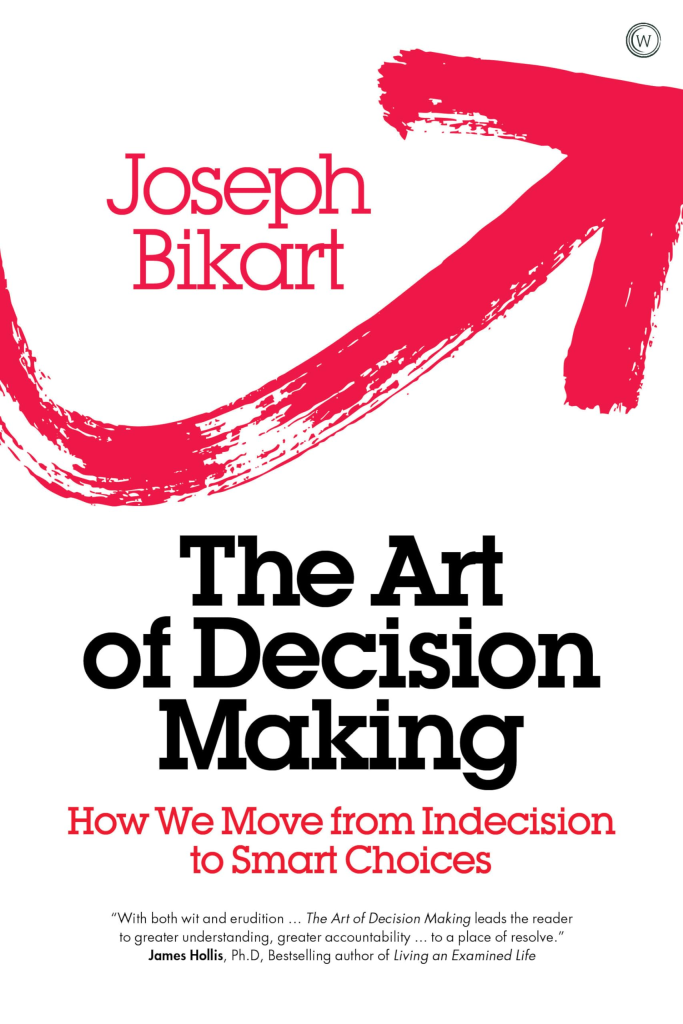The Art of Decision Making by Joseph Bikart
Decision-making is an essential part of life, shaping our identity and future. The Art of Decision Making explores the psychology, philosophy, and science behind choices. It provides practical strategies to approach decisions with clarity, confidence, and purpose. The book inspires readers to embrace challenges, trust intuition, and align decisions with their core values for a meaningful life.
Who May Benefit from the Book
- Individuals seeking personal growth and self-awareness.
- Professionals aiming to enhance decision-making skills.
- Students exploring the psychological and philosophical aspects of decisions.
- Readers intrigued by how creativity and intuition shape choices.
- Leaders wanting to navigate complex decisions effectively.
- Coaches or mentors guiding others in personal and professional growth.
- Those interested in understanding the role of language and perspective in choices.
Top 3 Key Insights
- Decisions shape our identity: Choices are opportunities for growth and self-discovery.
- Fear reveals deeper issues: Understanding and confronting fears leads to authentic decision-making.
- Intuition and creativity matter: Balancing logic with intuition improves decision outcomes.

7 More Lessons and Takeaways
- Discomfort leads to growth: Challenges in decision-making often signify meaningful personal development.
- Past experiences influence choices: Recognizing childhood patterns helps in making conscious decisions.
- Momentum fuels action: Small steps overcome inertia and build decision-making confidence.
- Perspective offers clarity: Gaining emotional distance can make tough decisions clearer.
- Our story unfolds through choices: Each decision contributes to our life’s narrative.
- Language shapes decisions: Words influence how we perceive and approach choices.
- Embrace ambiguity: Accepting uncertainty fosters flexibility and authentic decisions.
The Book in 1 Sentence
The book explores how decisions define us, blending psychology, philosophy, and practical strategies for meaningful choices.
The Book Summary in 1 Minute
Decisions are more than choices; they shape our identity and personal growth. Understanding fears and past influences can lead to more authentic decisions. Intuition and creativity complement logic in complex situations. Momentum, perspective, and language play crucial roles in effective decision-making. Embracing ambiguity and cultivating a proactive mindset allows for decisions aligned with our core values.
The Book Summary in 10 Minutes
The Role of Decisions in Shaping Identity
Decisions reflect who we are and what we value. Each choice contributes to our personal narrative and helps uncover hidden aspects of ourselves. Approaching decisions with curiosity, not fear, encourages growth and authenticity.
Overcoming Fear in Decision-Making
Fear often hides deeper psychological issues. Common fears include failure, success, and disappointing others. These stem from past experiences and influence current choices. By confronting fears directly, we make more conscious and courageous decisions.
The Importance of Creativity and Intuition
Effective decisions balance logic with intuition. Intuition leverages subconscious knowledge, offering insights beyond conscious reasoning. Creativity opens new possibilities, enhancing decision quality. Regular practices like journaling or visualization help cultivate these traits.
Building Momentum and Flow
Action overcomes decision paralysis. Starting small builds momentum, turning indecision into progress. Entering a state of flow, characterized by focus and motivation, simplifies complex decisions and keeps us moving forward.
| Momentum Tips |
|---|
| Break decisions into steps |
| Celebrate small wins |
| Stay adaptable |
Perspective and Emotional Distance
Gaining distance from decisions clarifies emotions and logic. Techniques like imagining future outcomes or advising a friend provide valuable perspective. Reframing decisions often reveals new insights.
Crafting Our Life Narrative
Our choices collectively tell our story. Reflecting on past decisions reveals patterns and values, guiding future choices. Aligning decisions with core values ensures a fulfilling and coherent life path.
Language and Decision Framing
Words shape perceptions of decisions. Empowering language promotes confidence and effective action. Developing a richer decision-making vocabulary allows for nuanced, thoughtful choices.
Embracing Ambiguity
Not all decisions have clear answers. Accepting uncertainty fosters resilience and creativity. Practices like mindfulness help navigate ambiguity and find balanced solutions.
Present-Focused Action
Engaging fully in the present empowers transformative decisions. Aligning actions with core values ensures authenticity and fulfillment, shaping a meaningful life.
About the Author
The author delves into decision-making through the lenses of psychology, philosophy, and history. With a background in these fields, they explore the factors influencing choices and provide insights for personal growth. Their writing bridges interdisciplinary perspectives to offer a deep understanding of human behavior and decision-making.
How to Get the Best of the Book
Read reflectively and apply the lessons to your life. Focus on key sections that address your challenges. Practice the suggested strategies to enhance clarity and confidence in decisions.
Conclusion
This book combines psychology, philosophy, and practical advice to redefine decision-making. It empowers readers to confront fears, embrace intuition, and craft choices aligned with their values. Its insights inspire personal growth and mindful decision-making.